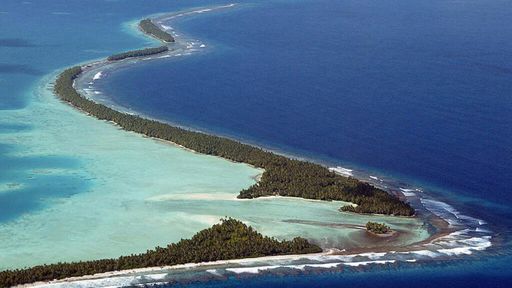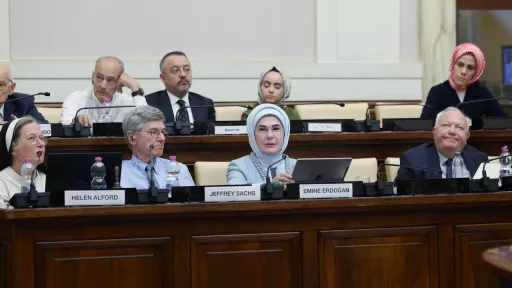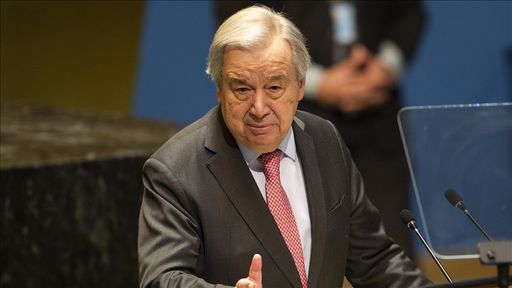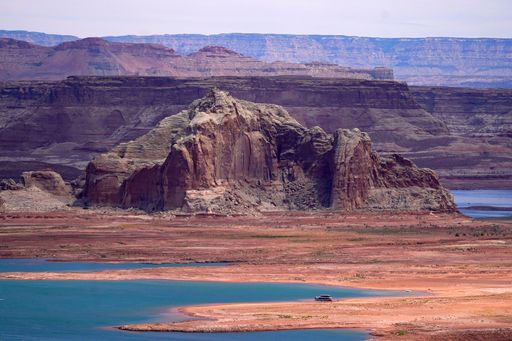A blue backdrop filled with flags sets the familiar stage of a diplomatic summit.
The camera zooms in on Simon Kofe, the foreign minister of the Pacific island-nation Tuvalu, delivering a speech on climate mobility.
As the frame slowly zooms out, the picture presents a shock-and-awe moment: he is standing knee-deep in seawater.
Kofe’s message is powerful and unmistakable: his country is disappearing. "We are sinking," he declared at COP26 — a moment that captured global attention.
Four years have passed since that speech, yet Tuvalu remains at the heart of climate discussions.
On June 16, Australia launched a first-of-its-kind visa programme driven by the realities of climate change.
Under a bilateral agreement, 280 Tuvaluan citizens will be selected annually through a random ballot between July 2025 and January 2026. Those chosen will receive permanent residency upon arrival, with the right to work, access public healthcare, and pursue education.

But what about the rest?
Scientists predict that most of Tuvalu will be under water in a few decades. As sea levels continue to rise, tidal surges, waves and storms will become increasingly destructive, and the frequency and severity of flooding will escalate dramatically.
Similar existential threats loom over nations like Kiribati, Bangladesh and the Marshall Islands, where rising tides and extreme weather accelerate displacement.
By signing a landmark agreement with Tuvalu, Australia has become one of the first countries to offer resettlement pathways for people facing displacement due to climate change.
But no binding definition of ‘climate refugee’ exists within current global frameworks. Efforts to broaden these definitions — including initiatives like the Global Compact on Refugees — have so far fallen short.
While some argue that expanding refugee definitions could blur legal lines, the urgency of climate displacement has renewed demands for decisive action.

The concerns over the growing number of climate refugees were at the heart of a recent panel discussion titled ‘Refugees: From Exile to Reconstruction?’ held during the International Law Conference at Bogazici University in Istanbul.
Moderated by Prof Satvinder Juss of King’s College London, the session brought together legal scholars to discuss the growing disconnect between law and lived experience, especially in the face of irreversible environmental change.
Prof Ali Wardak from the University of South Wales addressed the situation in Afghanistan, where drought and land degradation increasingly overlap with conflict-related displacement.
“We can no longer afford to separate the causes,” he warned, “because war and climate feed into each other.”
Dr Naziye Dirikgil of Sakarya University focused on the legal implications of temporary protection in permanent environmental loss.
She noted that Türkiye is drafting new climate legislation that may extend such protection to climate-displaced persons, though the legal classification remains uncertain.
In response to a specific query from TRT World, both experts acknowledged that international law offers no clear path for recognising climate refugees.
In an exclusive interview with TRT World on the sidelines of the event, Prof Juss gave detailed views on the legal and ethical dilemmas surrounding climate displacement and whether international law is equipped to face a future shaped by vanishing homelands.

Gaps in protection
The 1951 Refugee Convention remains a cornerstone of international refugee law. However, it was created more than 70 years ago in response to the refugee crisis in Europe after World War II, and its scope reflects the political and legal context of that period.
As a result, the Convention does not address the current drivers of displacement, particularly those related to climate change.
Juss proposes two paths forward to address the gaps.
One is to amend the Convention to include climate change as a basis for protection. The other is to reinterpret the existing legal text in a more imaginative and inclusive way, so that it reflects the realities of displacement in environmentally vulnerable and post-conflict societies.
Professor Juss says that climate-induced migration cannot be separated from global inequalities. He highlights how those most affected are often from the global south, where race and religion intersect with vulnerability.
“It is to look at the intersectionality, the extent to which refugees come predominantly as climate change refugees from the global south,” he says.

“And there is an intersection of those refugees based on their relationship with racial factors and religious factors insofar as it is the case that they are largely brown and black people.”
He adds that the failure of industrial countries to reduce emissions over decades has had a disproportionate impact on these communities.
“Because they are largely brown and black people, it would be possible to say that there is a racial element to them because over many many decades the global north has refused to restrict their greenhouse gas emissions which affect very very largely people in the global south on racial grounds, grounds that affect people largely of brown and black populations.”
In Professor Juss’s view, removing the term “climate change refugees” from legal vocabulary ignores reality and strips the issue of its moral urgency.
“Removing climate change refugees has the effect of depoliticising what is essentially a political act of persecution because everyone knows that the global north is not restricting its greenhouse gas emissions, he says.
“That impact is very much on the global south, island nations, and island populations. And by bringing in this idea of climate change refugees, you are making it clear that there is a political angle to it, very much in the way that brings it back into the Refugee Convention.”
This perspective highlights a crucial imbalance: while the Global North continues to emit disproportionately, the Global South bears the brunt of the climate crisis. Island nations like Tuvalu are at the forefront of this existential threat.
Though not traditional war zones, they face what could be termed a new kind of conflict, one defined by climate, not violence.
“At the moment, it does not recognise them as post-conflict societies. But, of course, if you get a situation where an island like Tuvalu is at risk of being submerged underwater, you could argue and make a case for saying that the conflict is already underway. It’s not a violent conflict, but a climatic one that has not been addressed for many decades. And in that sense, you could extend the language to include that.”
Beyond Tuvalu, this crisis plays out across much of the Global South. Scientists estimate that 2050 climate-related disasters could displace as many as 143 million people in these regions.
Despite the growing literature on climate-induced migration, most studies fail to examine how multiple climate hazards — such as rising temperatures, droughts, floods, and sea-level rise — overlap and intensify migration, mobility, and immobility.
Meanwhile, another layer of injustice emerges in the form of environmental exploitation. Western-origin waste being dumped in countries like Vietnam, Thailand, and Malaysia has sparked global outrage under the term “waste colonialism.”
This pattern of disproportionate burden, whether in emissions or waste, reinforces global inequality in the climate era.

New protocol
Even established legal protections like non-refoulement, which prohibits states from returning refugees to danger, may offer little support under the current legal definitions.
“The core principle of refugee law is non-refoulement, the idea that you will not return…non-return of genuine refugees,” Juss explains.
He says the issue lies in the lack of legal recognition for climate-displaced people — an untouched grey zone.
“There is, at this point, a non-recognition of climate change refugees, largely because they don’t fall under the Convention, the Refugee Convention, but secondly also because there hasn’t been that kind of interpretation of the Refugee Convention that enables climate change refugees to be included within it…”
This means that, legally speaking, sending back people displaced by climate change does not count as a breach of refugee law — at least for now.
As climate migration accelerates, Juss argues that waiting for reinterpretation of old laws is no longer viable. A new legal framework is needed and urgently.
“One could have a new protocol under international law that addresses specifically the needs of climate change refugees.”
“It does need addressing because the numbers are huge, they are far, far higher than conventional refugees, fleeing for reasons of individual persecution, or from strife-torn areas of the world where there is conflict.”
And this is no longer a problem confined to the Global South.
“The numbers are huge, and they’re affecting the whole of the global south — countries like Pakistan, Afghanistan, island nations, large parts of Africa…”
“But now, there is much more, including the north. The United States and California, the fires and hot summers in Germany, Europe, England, and so on and so forth.”
As the planet warms, so does the urgency for humanitarian and legal action.




















